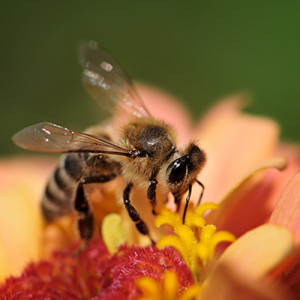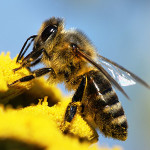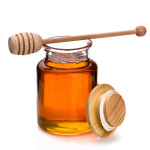 Many people are aware of the global decline in bee population, although not of the very serious impact on the environment (and even our own survival). Due to colony collapse disorder (CCD), many bees leave their hives only to never come home. While there are many possible causes of the disappearance, from the use of neonicotinoid insecticide to mites, scientists still can’t find one definite main factor.
Many people are aware of the global decline in bee population, although not of the very serious impact on the environment (and even our own survival). Due to colony collapse disorder (CCD), many bees leave their hives only to never come home. While there are many possible causes of the disappearance, from the use of neonicotinoid insecticide to mites, scientists still can’t find one definite main factor.
To help honey bees thrive in your own backyard to help bring populations back up, here are 6 simple things you can do:
1. Avoid using commercial pesticides, fertilizers, and herbicides.
The use of insecticide has contributed to the problem of dying bees (and to health problems in humans and other animals as well). While there is much debate about how much its use affects the bee population, there are still plenty of benefits to enjoy by not using products containing insecticides. Whenever possible, look for organic ways to encourage your garden to flourish.
2. Let your lawn overgrow now and again.
Bees love visiting clovers and dandelions. While your lawn may be unsightly for a while, just think about how much good you’ll be doing for any busy bees in your area. Since honey bees travel nearly 5 kilometres from their hives to harvest, you’ll help make their trip to your yard well worth the effort.
3. Plant bee-friendly flowers.
If you want to breathe some life into your yard and help honey bees, you can do some landscaping. You don’t even have to do anything too difficult – just buying some pots of flowers for your deck or placing them along a walkway can work wonders.
When choosing flowers and plants, keep the following in mind:
- Choose a variety of plants that flower at different times of the year to always have something available for bees to harvest from.
- Make the plants easy to spot by planting them in clusters and choosing varieties that are blue, purple, violet, white and/or yellow since bees seem especially attracted to such colours.
- Different species of bees have different tongue lengths so be sure to choose varieties that all bees can benefit from. For example, honey bees have short tongues and prefer open flowers.
- Local plants tend to attract more native bees while exotic plants tend to attract more honey bees.
Bees also love frolicking around in fruit and vegetable gardens. By planting fruits and veggies, you will be helping the bees help you get fresh food to enjoy. Our tomato yield has gone up since our bees arrived, and we’ve found that they also enjoy broccoli flowers and scarlet runner beans!
4. Put out some sugar water for exhausted bees.
After a long day of foraging, some bees are so exhausted that they simply can’t make it back to their hives. To help bees reenergize while foraging, you can leave sugar water to boost their energy. To make sugar water, just mix one part granulated sugar to two or three parts hot water (you may need to experiment a bit but the sugar water should not be quite as thick as syrup). Make sure to dissolve the sugar completely and let it cool some before serving it to bees.
To help prevent drowning the bees, here are some tips:
- Keep the sugar water in a shallow layer (such as just a light layer on the lid of a bucket).
- Place corks cut in half into the sugar water for bees to land on and drink from.
- Place bark, a stick, or something else in the bucket or bowl and lean it against the side of the container for bees to easily land on the rim of the container, use the ramp down to the water, and climb back up and out again.
With sugar water, be sure to change it out every few days to prevent the water from going bad.
5. Support local beekeepers.
Local beekeepers take great pride in their work and their bees, and usually do everything they can to ensure that their products are organic to ensure the safety of both humans and wildlife. Unfortunately, since many local beekeepers tend to run smaller operations, they really take a hit when bees die off or disappear from their hives.
Whenever you can, consider buying local honey products. Many beekeepers have products on the shelves in local specialty stores or sold from farmers’ markets. By supporting local beekeepers, you will not only get quality honey but help support the work that they do as well.
6. Give honey bees a voice.
If you want to take even more of a stand for bees, get talking. Whether you’re sharing this article about dying bees to friends and family or contacting politicians to voice your concerns, it’s important to spread the word. By raising awareness and advocating for bees, you will do your part in saving bees and also the future of humankind as well.
More Reading:
http://www.mnn.com/earth-matters/wilderness-resources/stories/5-ways-to-help-our-disappearing-bees
http://www.care2.com/greenliving/7-ways-to-help-honey-bees.html
http://www.pbs.org/wnet/nature/episodes/silence-of-the-bees/how-can-you-help-the-bees/36/
http://www.davidsuzuki.org/what-you-can-do/food-and-our-planet/create-a-bee-friendly-garden/



